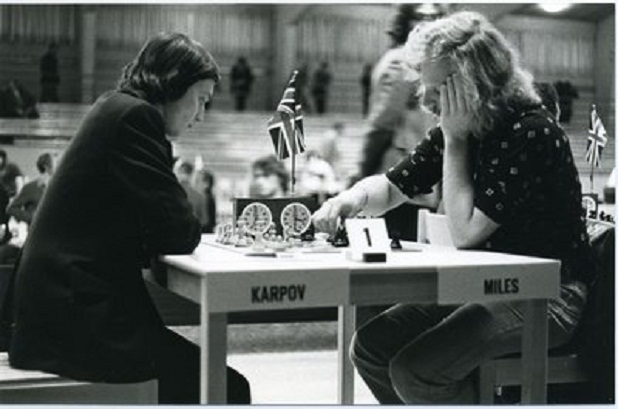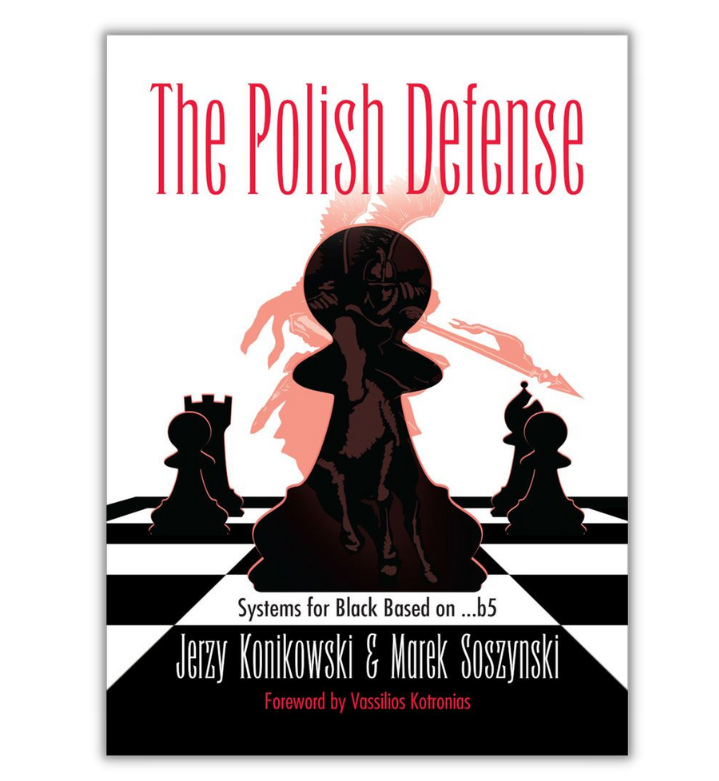Given the bad news about the death at the end of 2022 of Mike Basman, the great English chess maverick, it seems timely to see a new book featuring one of his favorite openings.
The Polish Defense by Jerzy Konikowski and Marek Soszynski examines ‘Systems for Black Based on …b5’. In each case, the …b5 moves come remarkably early in the game; usually on the very first move, in fact. A lot of the resulting play is out of this world, as acknowledged by the book’s blurb:
“There can be no Plan B because there is no Planet B,” said UN Secretary-General Ban Ki-moon. We disagree when it comes to chess. In this book you will see analyzed not only 1. d4 b5 (the Polish Defense) but also the St. George Defense (1. e4 e6 2. d4 a6 intending 3…b5), 1. Nf3 b5, also 1. f4 b5 and, most shocking of all, 1. e4 a6 2. d4 b5. Grandmasters have lost to these systems; other Grandmasters even try them out themselves when they have the black pieces. No, an early …b7-b5 is not Plan A. However, if you want to humiliate the opposition by being literally eccentric (off-center) and disrespectful … Welcome to Planet B!’’
Basman’s interest in the opening predates his main love of the Grob (1.g4 and 1…g5) but he was instrumental in making lines with an early …b5 more respectable. As part of their historical retrospective of the defenses covered in their book, the authors explain:
‘Fast forward to the 1980s and English IM Michael Basman, openings experimenter extraordinaire, issues his Play the St. George book in which he analyzes various …b7-b5 systems, including his preferred 1. e4 e6 2. d4 a6 (then 3…b5), which he himself had been playing since the late 1970s. But why did he name it for the patron saint of England? Partly because in the European Team Championships of 1980, the English GM Tony Miles famously employed 1. e4 a6 2. d4 b5 to beat the Soviet Union’s top board, Anatoly Karpov, and thus help England earn an unlikely draw against the tourney favorites – which brought to mind the legend of St. George and the Dragon, in which the hero… and you can guess the rest.’
As an example of the book’s thoroughness, the number of options analyzed after the standard opening moves 1. d4 b5 2. e4 Bb7 is very impressive, given that this opening rarely receives any coverage whatsoever.
Here, the following White tries are all examined: 3. Bd3, 3. f3, 3. Nd2, 3. Bxb5, 3. d5 Nf6, 3. e5 e6 4. Nf3 a6 and 3. Qf3?!
Playing unusual openings can be a double-edged sword. There is a reason such openings are not often played by very strong players and to rely on 1 …b5 all of the time would probably lead to diminishing returns. As is often the case, such oddball openings are best used as occasional surprise weapons, especially in Blitz or Rapidplay games.
Players of a certain age will almost certainly remember the fuss caused by the most famous of all games featuring the St. George Defense. For the younger readers, here is what happened.
Anatoly Karpov – Tony Miles
Skara,1980
At this time, Karpov was an absolutely dominant World Champion. He very rarely lost any games at all, and he was virtually invincible with the white pieces.
Tony Miles was a fighter on the chess board but usually struggled against Karpov (as did everyone else). Perhaps out of desperation (his usual openings, such as the Sicilian Dragon, were ineffective against Karpov) he met the champion’s then-habitual 1. e4 with 1…a6. At the time, this move was considered an insult, but nobody would have suspected a major shock was in store.
This is the critical position of the game. Black has just castled, giving Karpov the opportunity to play the Greek Gift sacrifice with 19. Bxh7!? In the game, he thought for half an hour and played 19. Ng5, but his subsequent play was not up to his normal standard. Miles won a pawn and then converted his advantage in the endgame. Debate still rages over Karpov’s decision. The sacrifice is not as clear as most Greek Gift sacrifices and Karpov was never one to indulge in anything speculative. Konikowski and Soszynski provide plenty of interesting analysis which readers should find to be of interest.

The book concludes with 111 unannotated games, for further, independent study. This is where the reader will find the Forward Chess facilities particularly helpful. One can play through the moves via the on-screen board and use an engine to follow the ebb and flow of each game.
There are some big names defending the honour of 1…b5 too, such as David Howell and Jorden Van Foreest and, of course, Mike Basman himself, who was still playing the St. George to the end.
Indeed, we shall conclude with a snippet in his honor, in which the b-pawn, having gallantly advanced on the first move, didn’t move again until the time was right – which happened to be on move 47, when it strolled forward for a winning promotion.
Why not give 1…b5 a try in your own games, using this book as your guide?
Sean Marsh
- The Life and Games of Dragoljub Velimirovic (Volume 2) by Georg Mohr and Ana Velimirovic-Zorica - July 23, 2024
- Review: Chess Informant - June 7, 2024
- Is it time for a Modern Benoni revival - April 17, 2024

